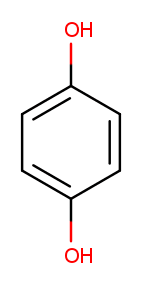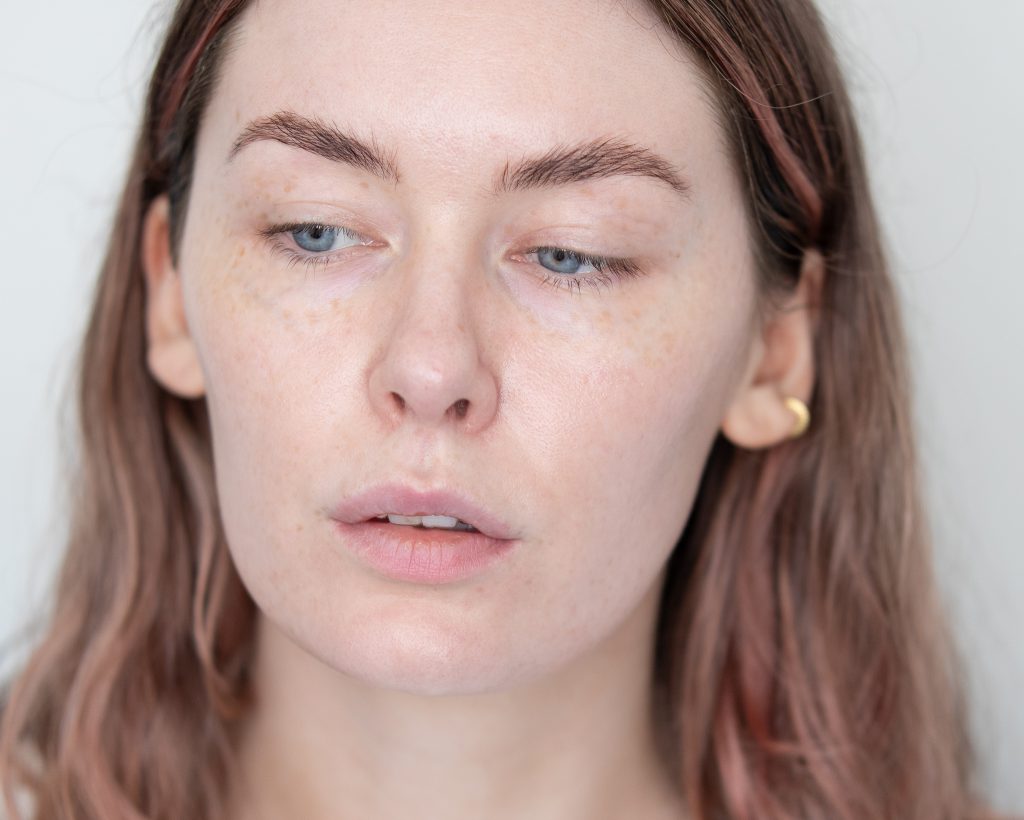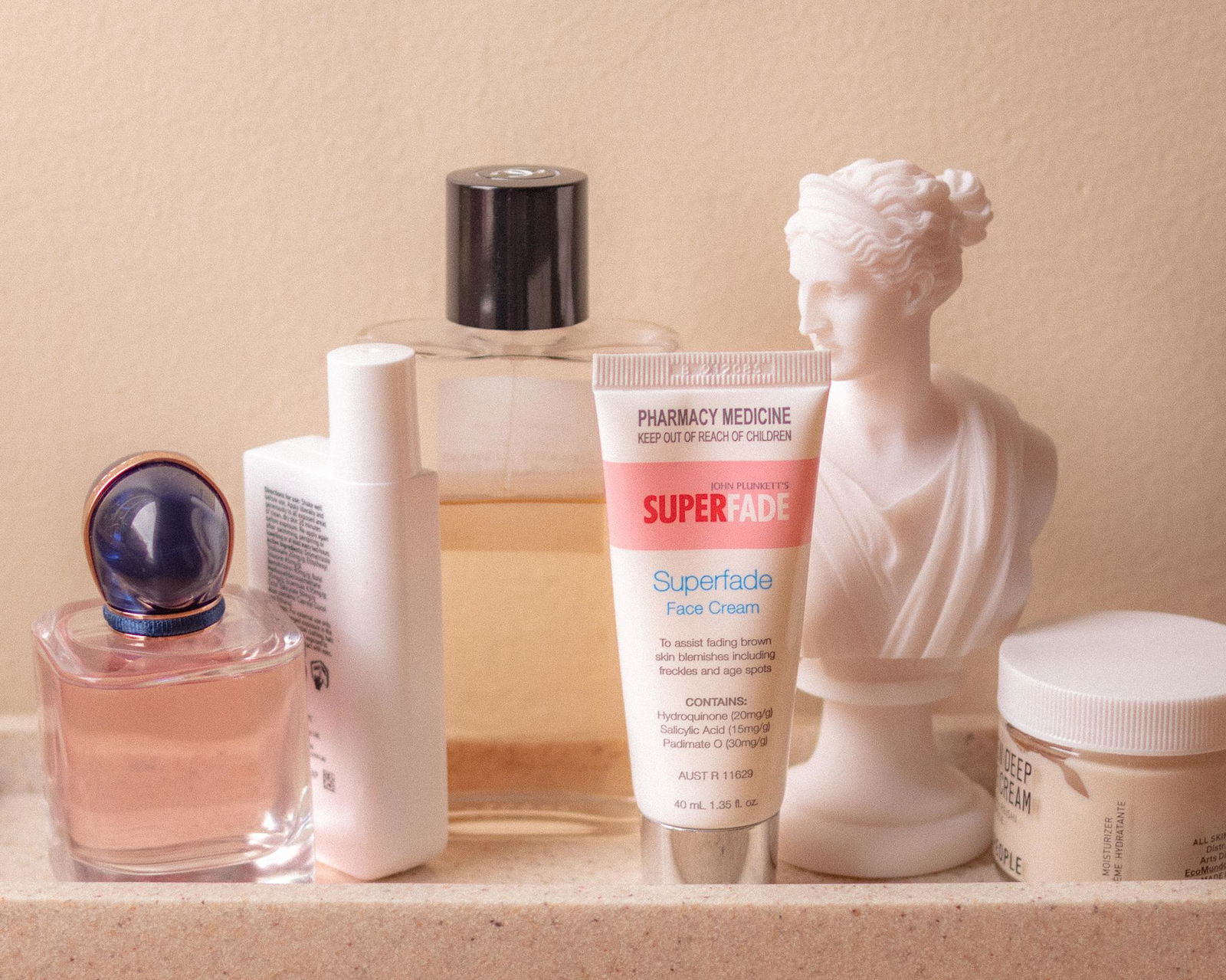This blog post is sponsored by John Plunkett’s Superfade Cream.
If we’ve known each other a while, you’ve definitely heard of retinoids as the gold standard in skincare for anti-aging. It is my pleasure to now introduce you to hydroquinone – the gold standard in skincare for hyperpigmentation. We’ll cover everything you need to know, including how to get it in Australia without a prescription. Excited? Same. Let’s dive in.
What is hydroquinone?
Easily synthesised in a lab OR found in nature (for example in bee propolis or bearberry), hydroquinone is a small molecule regarded as the gold standard for treatment of hyperpigmentation disorders. It’s a powerful pigment blocker!
If you want the hard science, hydroquinone competitively inhibits melanin synthesis by acting as a substrate for tyrosinase – an enzyme involved in producing melanin.
In plain language, hydroquinone works on your melanin-producing cells (melanocytes) by fitting into the tyrosinase enzyme, keeping it occupied so it’s not able to make melanin. On a large scale, this means slowed melanin production for you, and thus less melanin showing up in your skin as hyperpigmentation. Hydroquinone comes highly regarded due to the wealth of peer-reviewed research supporting its efficacy. Clinical studies into hydroquinone consistently report excellent results for treatment of hyperpigmentation, and have done for a long, long time. You can see results with as little as a 2% concentration. And dermatologists love it!

hannahenglish.com.au
What is hydroquinone used for?
Hydroquinone is used for treatment of hyperpigmentation disorders, which are defined as darkening of the skin or nails, caused by excess melanin. It evens out the skin tone by lightening hyperpigmentation – this could be freckles, age spots, melasma, or leftover pigmentation from acne. It’s brilliant for use leading up to a salon peel, too. By pre-treating with a potent pigment blocker like hydroquinone, you can help to ensure that the dark spot formation is interrupted in new skin cells being formed. This way, when you peel off the older, damaged cells, you’ll see more of a dramatic result. Speak to your dermatologist, derm nurse, or dermal clinician if you think this is right for you
How do I get hydroquinone in Australia?
It’s actually quite easy!
In Australia, hydroquinone is available over the counter in pharmacies at concentrations of 2% or less. You have to get it from a pharmacy because it’s considered an actual medicine with a clinical effect, so there are special labelling requirements. It must also be registered with the TGA. Ask your pharmacist for John Plunkett’s Superfade Face Cream, formulated with 2% hydroquinone and 1.5% salicylic acid, a chemical exfoliant to help with delivery into the skin. It’s $AU21.99, and you don’t even need a prescription!
Hydroquinone cream is also commonly prescribed by dermatologists at 4%, 5%, 6%, or even 10%. You might have heard of the fabled Kligman’s Pigmentation Cream – this contains hydroquinone 5%, tretinoin 0.1%, another gold standard but for overall anti-aging, and dexamethasone 0.1%, a steroid to mitigate any irritation. Higher concentrations are not always better – I’m a huge advocate of starting at a low dose and giving my skin a chance to see results before I take on anything as serious as a prescription face cream.
Will it work for my skintone? Are there side effects?
Hydroquinone is suitable for all skintones. Despite what you may have heard, there’s no clinical evidence suggesting topical hydroquinone is anything less than safe when used correctly.
It’s best used as a spot treatment and not all over, as it may lighten all of your skin. Do not use hydroquinone to lighten your overall skin colour.
It’s also best used in 3-month stints, followed by maintenance as required.
You might experience side effects like irritation, redness, itching, stinging, or inflammation when beginning use of a hydroquinone cream.
Halo spots are another potential side effect – because the cream is excellent at skin lightening, it can also lighten the skin around your dark spot, leaving a lighter “halo”. Don’t worry though, we’ll talk about all things HQ introduction and use in the next section.
There is a rare side effect of hydroquinone overuse called ochronosis, which is darkening of skin where the product was applied. This can occur if hydroquinone is used in a contaminated product, or for too long, or at too high a concentration. It’s not something to worry about with normal use, as it’s easily avoided by;
- Following the labelled directions and
- Purchasing a reputable product from a reputable supplier, like your local pharmacy.
How do I introduce hydroquinone into my skincare regimen?
First of all, you need to wear sunscreen daily. And reapply!
The best sunscreen is one you’ll use regularly, and it’s important to look for one with high UVA protection. In Australia, look for “broad spectrum” on the label and an SPF of at least 30+. The higher, the better.
Hyperpigmentation is both caused and exacerbated by sun exposure, so skipping sunscreen will set you up for an uphill battle.
Now for some good news – hydroquinone cream is compatible with your existing skincare.
Be careful when combining with strong actives like retinol.
As with any new skincare, you should always patch test first on an isolated area. I patch test one per day for 2 days, on my forearm or behind my ear.
From here, it’s a great idea to apply after cleansing, and before any other serums. Another way to ensure the best result is to look for a hydroquinone cream formulated with salicylic acid, such as Superfade Cream. The salicylic acid is there to help the hydroquinone penetrate into the skin.
Introduce the cream by using once daily, at night, and look out for any signs of stressed skin. Try applying it with a cotton bud for precision! From here, you can increase to 2 or even 3 times daily.
If your skin is sensitive, hydroquinone might work better for you if used every second day. Results will take longer, but it’s worth it to prevent potential irritation. If you experience mild irritation, this is normal as your skin adjusts to the new treatment. If you experience severe irritation, this may not be the treatment for you. It’s best to cease use and check in with your GP or dermatologist.

How long does it take to see results from hydroquinone cream?
Dark spots won’t fade overnight, but it happens pretty quickly! Pigmentation is formed over a long period of time, so it takes time and a consistent routine to fade. Used daily, you can expect noticeable results from a hydroquinone product in 6-12 weeks. From here, take a break for a couple months, see how you’re travelling, and repeat the cycle as required.
Altogether,
Hydroquinone cream is a well-researched and very effective treatment for dark spots. Like any medicine, it’s best to read the label and use as directed.
Superfade Face Cream label information:
Do not use on children. Do not use near the eyes. Do not exceed the recommended dose. Excessive or prolonged use should be avoided because darkening of the skin can occur.
While using this product, mild irritation may occur, stop use if it becomes severe. Avoid exposure to the sun. Use SPF30 sunscreen on any exposed areas. This product may darken on exposure to air, but this does not affect its efficacy.
Ask a doctor if a pigmented spot or mole has recently become darker, changed colour, become enlarged or itchy, or bleeds, then do not use this product. Ask your doctor if fading is not evident in three months.
